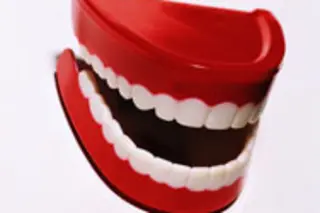1 Watch what you bite: Enamel, the sturdiest substance in the body, is harder than a copper bullet but slightly less hard than a stainless-steel fork.
2 Enamel also develops tiny cracks that diffuse the stress of chewing and help prevent breaks. Aerospace engineers are studying this feature with an eye toward creating stronger spacecraft.
3 Yet your teeth cannot always stand up to your mouth’s native population of bacteria, which produce acids that leach calcium and phosphate from the enamel—the process that leads to cavities.
4 Nothing personal: Those acids are an accidental by-product created when the bacteria digest sugars in the food you’ve eaten. (Before the invention of refined sugar, cavities were rare.)
5 Fluoride counters tooth decay by preventing the loss of minerals from enamel and promoting reabsorption of calcium and phosphate from saliva into the enamel.
6 In 1945, Grand Rapids, Michigan, became the first community ...















